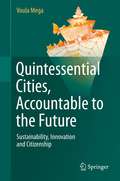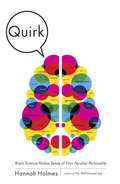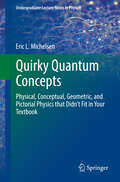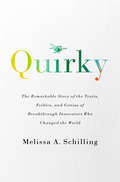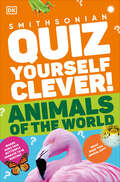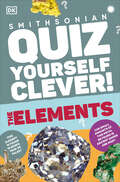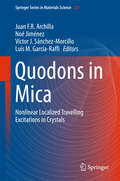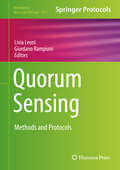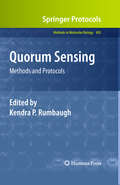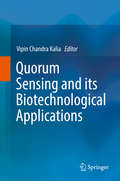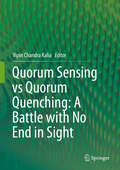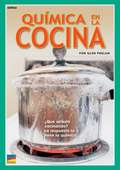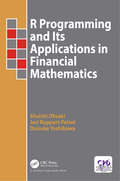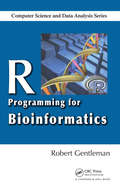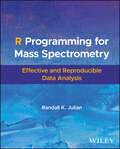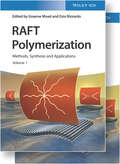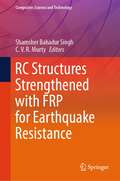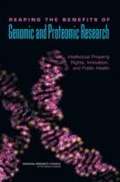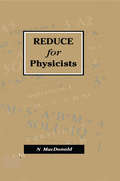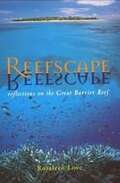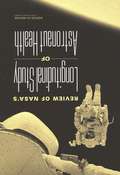- Table View
- List View
Quintessential Cities, Accountable to the Future: Sustainability, Innovation and Citizenship
by Voula MegaThis book can be seen as the third part of an unofficial trilogy on Sustainable Cities of the Future with the author's previous books 'Sustainable Development, Energy and the City' and 'Sustainable Cities for the third millennium: The Odyssey of urban excellence', both prefaced by Prof. Sir Peter Hall. All three books follow the evolving forefront of innovations towards Sustainable Cities. They collectively try to respond to the questions: What future cities wish to build (with their scarcities and capacities) on a finite planet? What do-they do to achieve this? How do-they contribute to redesign the world? The third book adopts, first and foremost, a strategic foresight approach including a scan of the future trends, tensions and risks in a more uncertain world, the possible and preferable futures, emerging policy issues, such as intergenerational cities or cities welcoming the immigrants and their impact on sustainable development, the Rio+20 prospects and the effects of the protracted crisis, efforts by world interconnected cities, including a case-study on Bangkok, a laboratory of urban change, and examples of frugal and resilient urban policies.
Quirk: Brain Science Makes Sense of Your Peculiar Personality
by Hannah HolmesWho are you? It's the most fundamental of human questions. Are you the type of person who tilts at windmills, or the one who prefers to view them from the comfort of an air-conditioned motorcoach? Our personalities are endlessly fascinating--not just to ourselves but also to our spouses, our parents, our children, our co-workers, our neighbors. As a highly social species, humans have to navigate among an astonishing variety of personalities. But how did all these different permutations come about? And what purpose do they serve? With her trademark wit and sly humor, Hannah Holmes takes readers into the amazing world of personality and modern brain science. Using the Five Factor Model, which slices temperaments into the major factors (Extraversion, Neuroticism, Agreeableness, Conscientiousness, and Openness) and minor facets (such as impulsive, artistic, or cautious), Holmes demonstrates how our genes and brains dictate which factors and facets each of us displays. Are you a Nervous Nelly? Your amygdala is probably calling the shots. Hyperactive Hal? It's all about the dopamine. Each facet took root deep in the evolution of life on Earth, with Nature allowing enough personal variation to see a species through good times and bad. Just as there are introverted and extroverted people, there are introverted and extroverted mice, and even starfish. In fact, the personality genes we share with mice make them invaluable models for the study of disorders like depression, schizophrenia, and anxiety. Thus it is deep and ancient biases that guide your dealings with a very modern world. Your personality helps to determine the political party you support, the car you drive, the way you eat M&Ms, and the likelihood that you'll cheat on your spouse. Drawing on data from top research laboratories, the lives of her eccentric friends, the conflicts that plague her own household, and even the habits of her two pet mice, Hannah Holmes summarizes the factors that shape you. And what she proves is that it does take all kinds. Even the most irksome and trying personality you've ever encountered contributes to the diversity of our species. And diversity is the key to our survival.
Quirks of Human Anatomy: An Evo-devo Look at the Human Body
by Lewis I. Held Jr.With the emergence of the new field of evolutionary developmental biology we are witnessing a renaissance of Darwin's insights 150 years after his Origin of Species. Thus far, the exciting findings from "evo-devo" have only been trickling into college courses and into the domain of non-specialists. With its focus on the human organism, Quirks of Human Anatomy opens the floodgates by stating the arguments of evo-devo in plain English, and by offering a cornucopia of interesting case studies and examples. Its didactic value is enhanced by 24 schematic diagrams that integrate a host of disparate observations, by its Socratic question-and-answer format, and by its unprecedented compilation of the literature. By framing the "hows" of development in terms of the "whys" of evolution, it lets readers probe the deepest questions of biology. Readers will find the book not only educational but also enjoyable, as it revels in the fun of scientific exploration.
Quirky Quantum Concepts
by Eric L. MichelsenQuirky Quantum Concepts explains the more important and more difficult concepts in theoretical quantum mechanics, especially those which are consistently neglected or confusing in many common expositions. The emphasis is on physical understanding, which is necessary for the development of new, cutting edge science. In particular, this book explains the basis for many standard quantum methods, which are too often presented without sufficient motivation or interpretation. The book is not a simplification or popularization: it is real science for real scientists. Physics includes math, and this book does not shy away from it, but neither does it hide behind it. Without conceptual understanding, math is gibberish. The discussions here provide the experimental and theoretical reasoning behind some of the great discoveries, so the reader may see how discoveries arise from a rational process of thinking, a process which Quirky Quantum Concepts makes accessible to its readers. Quirky Quantum Concepts is therefore a supplement to almost any existing quantum mechanics text. Students and scientists will appreciate the combination of conversational style, which promotes understanding, with thorough scientific accuracy.
Quirky: The Remarkable Story of the Traits, Foibles, and Genius of Breakthrough Innovators Who Changed the World
by Melissa A SchillingThe science behind the traits and quirks that drive creative geniuses to make spectacular breakthroughsWhat really distinguishes the people who literally change the world--those creative geniuses who give us one breakthrough after another? What differentiates Marie Curie or Elon Musk from the merely creative, the many one-hit wonders among us?Melissa Schilling, one of the world's leading experts on innovation, invites us into the lives of eight people--Albert Einstein, Benjamin Franklin, Elon Musk, Dean Kamen, Nikola Tesla, Marie Curie, Thomas Edison, and Steve Jobs--to identify the traits and experiences that drove them to make spectacular breakthroughs, over and over again. While all innovators possess incredible intellect, intellect alone, she shows, does not create a breakthrough innovator. It was their personal, social, and emotional quirkiness that enabled true genius to break through--not just once but again and again.Nearly all of the innovators, for example, exhibited high levels of social detachment that enabled them to break with norms, an almost maniacal faith in their ability to overcome obstacles, and a passionate idealism that pushed them to work with intensity even in the face of criticism or failure. While these individual traits would be unlikely to work in isolation--being unconventional without having high levels of confidence, effort, and goal directedness might, for example, result in rebellious behavior that does not lead to meaningful outcomes--together they can fuel both the ability and drive to pursue what others deem impossible. Schilling shares the science behind the convergence of traits that increases the likelihood of success. And, as Schilling also reveals, there is much to learn about nurturing breakthrough innovation in our own lives--in, for example, the way we run organizations, manage people, and even how we raise our children.
Quiz Yourself Clever! Animals of the World (DK Quiz Yourself Clever )
by DKDiscover your own inner Attenborough with this fact-packed, quick-quiztastic book, which covers more than 120 animals, from terrifying tigers to adorable apes!This amazing book welcomes you to the animal kingdom where you can meet more than 100 species, ranging from lions to butterflies and everything in between. Stunning pictures and fast facts will allow you to amass a wealth of knowledge in a fun way. Meet familiar creatures, including polar bears and tigers, and unbelievable ones, such as a vampire bat and a trumpetfish, with each animal having its own quiz questions to test your knowledge on what you've learned. For even more fun, get friends involved and quiz each other!Every creature is shown in beautiful detail, with quiz questions surrounding its portrait. Turn the page to find the answers to the questions—delivered in fast-fact style, including what they eat, where they live, how big they are compared to humans, and more images and facts. A jaw-dropping spectrum of animal types—from fish and birds to reptiles and mammals—provides a learning experience like no other!
Quiz Yourself Clever! Elements (DK Quiz Yourself Clever )
by DKGet to grips with the elements through fun quizzes.The periodic table sets out the humble ingredients of everything in the universe, but with 118 elements, that's a lot of ingredients to remember! This is where Quiz Yourself Clever! Elements comes in.The pure form of every element on the periodic table is shown via an eye-catching image, surrounded by quiz-style questions. Turn the page to find the answers, contained in a handy dataset, from its atomic number and mass to its melting point, and even when it was discovered. Images of how it appears in nature and its uses give a fuller understanding of each element.You can use the book to test your own knowledge, or how about using it to quiz a friend? So, whether you're studying for exams, want to play fun games with friends, or you're just curious about the building blocks of everything around you, you'll be in your element with this book before you know it!
Quodons in Mica
by Juan F. R. Archilla Noé Jiménez Victor J. Sánchez-Morcillo Luis M. García-RaffiThis book presents the current knowledge about nonlinear localized travelling excitations in crystals. Excitations can be vibrational, electronic, magnetic or of many other types, in many different types of crystals, as silicates, semiconductors and metals. The book is dedicated to the British scientist FM Russell, recently turned 80. He found 50 years ago that a mineral mica muscovite was able to record elementary charged particles and much later that also some kind of localized excitations, he called them quodons, was also recorded. The tracks, therefore, provide a striking experimental evidence of quodons existence. The first chapter by him presents the state of knowledge in this topic. It is followed by about 18 chapters from world leaders in the field, reviewing different aspects, materials and methods including experiments, molecular dynamics and theory and also presenting the latest results. The last part includes a personal narration of FM Russell of the deciphering of the marks in mica. It provides a unique way to present the science in an accessible way and also illustrates the process of discovery in a scientist's mind.
Quorum Sensing
by Livia Leoni Giordano RampioniThis detailed volume provides scientists interested in quorum sensing with a broad spectrum of methods and protocols useful for studying bacterial communication processes at the chemico-physical, molecular, and physiological level. Divided into three sections, the content covers detection and quantification of quorum sensing signal molecules, methods for the studying of quorum sensing at the molecular, physiological, and population level, as well as identification and characterization of anti-quorum sensing agents. Written for the highly successful Methods in Molecular Biology series, chapters include introductions to their respective topics, lists of the necessary materials and reagents, step-by-step, readily reproducible laboratory protocols, and tips on troubleshooting and avoiding known pitfalls. Authoritative and cutting-edge, Quorum Sensing: Methods and Protocols serves as a comprehensive guide to the most important methodology currently available in the field.
Quorum Sensing
by Kendra P. RumbaughSince its early days in the 1990s, the Quorum Sensing (QS) field has grown from a few dozen laboratories, investigating the pathways, proteins, and chemicals that facilitate signaling in bacteria, to hundreds of groups that have integrated evolutionary biology, computer science, mathematics, engineering, and metagenomics to create an ever-expanding and dynamic field. In Quorum Sensing: Methods and Protocols, expert researchers provide an in-depth set of diverse protocols that span this broad area of study. Broken into three detailed sections, the volume covers the detection, isolation, and characterization of the QS signals made by both Gram- and Gram+ bacteria, determination of the function of QS signals in vivo, and the development of QS disruption strategies. Written in the highly successful Methods in Molecular BiologyTM series format, chapters include brief introductions to their respective topics, lists of the necessary materials and reagents, step-by-step, readily reproducible laboratory protocols, and expert tips on troubleshooting and avoiding known experimental pitfalls. Comprehensive and cutting-edge, Quorum Sensing: Methods and Protocols serves as an invaluable collection of easily accessible techniques for scientists seeking to further our knowledge about bacterial communication and its relation to humanity.
Quorum Sensing and its Biotechnological Applications
by Vipin Chandra KaliaThis book delves into the biotechnological applications of Quorum sensing (QS)- a peculiar gene-regulatory process of some microorganisms. Quorum Sensing allows a large bacterial population to work together in a coordinated manner to carry out metabolic activities, which individual bacterium cannot. The different chapters describe how, associating bioremediation process with energy generation is an economical proposal, for reducing pollution and managing biowastes. The book discusses how QS can be exploited for biotechnological applications in generating bioproducts, bioenergy, bioremediation, biosensors, health and agricultural activities. It further highlights how QS is becoming an integral part of synthetic biology for genetic circuits for producing: (i) novel products, (ii) biosensors, (iii) bioactive molecules, etc. The book is divided into different sections for a clear understanding of the applicability of QS in, the Environment, Energy, Agriculture and Health sectors.
Quorum Sensing vs Quorum Quenching: A Battle with No End in Sight
by Vipin Chandra KaliaMicrobial relationships with all life forms can be as free living, symbiotic or pathogenic. Human beings harbor 10 times more microbial cells than their own. Bacteria are found on the skin surface, in the gut and other body parts. Bacteria causing diseases are the most worrisome. Most of the infectious diseases are caused by bacterial pathogens with an ability to form biofilm. Bacteria within the biofilm are up to 1000 times more resistant to antibiotics. This has taken a more serious turn with the evolution of multiple drug resistant bacteria. Health Departments are making efforts to reduce high mortality and morbidity in man caused by them. Bacterial Quorum sensing (QS), a cell density dependent phenomenon is responsible for a wide range of expressions such as pathogenesis, biofilm formation, competence, sporulation, nitrogen fixation, etc. Majority of these organisms that are important for medical, agriculture, aquaculture, water treatment and remediation, archaeological departments are: Aeromonas, Acinetobacter, Bacillus, Clostridia, Enterococcus, Pseudomonas, Vibrio and Yersinia spp. Biosensors and models have been developed to detect QS systems. Strategies for inhibiting QS system through natural and synthetic compounds have been presented here. The biotechnological applications of QS inhibitors (QSIs) in diverse areas have also been dealt with. Although QSIs do not affect growth and are less likely to impose selective pressure on bacteria, however, a few reports have raised doubts on the fate of QSIs. This book addresses a few questions. Will bacteria develop mechanisms to evade QSIs? Are we watching yet another defeat at the hands of bacteria? Or will we be acting intelligently and survive the onslaughts of this Never Ending battle?
Quṭb al-Dīn Shīrāzī and the Configuration of the Heavens: A Comparison of Texts and Models
by Kaveh NiaziAs a leading scientist of the 13th century C. E. Quṭb al-Dīn Shīrāzī wrote three substantial works on hay'a (or the configuration of the celestial orbs): Nihāyat al-idrāk fī dirāyat al-aflāk ("The Limits of Attainment in the Understanding of the Heavens"), al-Tuḥfa al-shāhīya fī 'ilm al-hay'a ("The Royal Offering Regarding the Knowledge of the Configuration of the Heavens"), and Ikhtīyārāt-i Muẓaffarī ("The Muẓaffarī Elections"). Completed in less than four years and written in two of the classical languages of the Islamic world, Arabic and Persian, these works provide a fascinating window to the astronomical research carried out in Ilkhanid Persia. Shīrāzī and his colleagues were driven by their desire to rid Ptolemaic astronomy from its perceived shortcomings. An intriguing trail of revisions and emendations in Shīrāzī's hay'a texts serves to highlight both those features of Shīrāzī's astronomy that were inherited from his predecessors, as well as his original contributions to this branch of astronomical research. As a renowned savant, Shīrāzī spent a large portion of his career near centers of political power in Persia and Anatolia. A study of his scientific output and career as a scholar is an opportunity, therefore, for an examination of the patronage of science and of scientific works within the Ilkhanid realms. Not only was this patronage important to the work of scholars such as Shīrāzī but it was critical to the founding and operation of one of the foremost scientific institutions of the medieval Islamic world, the Marāgha observatory. The astronomical tradition in which Shīrāzī carried out his research has many links, as well, to the astronomy of Early Modern Europe, as can be seen in the astronomical models of Copernicus.
R Programming and Its Applications in Financial Mathematics
by Shuichi Ohsaki Jori Ruppert-Felsot Daisuke YoshikawaThis book provides an introduction to R programming and a summary of financial mathematics. <P><P>It is not always easy for graduate students to grasp an overview of the theory of finance in an abstract form. For newcomers to the finance industry, it is not always obvious how to apply the abstract theory to the real financial data they encounter. Introducing finance theory alongside numerical applications makes it easier to grasp the subject. <P><P>Popular programming languages like C++, which are used in many financial applications are meant for general-purpose requirements. They are good for implementing large-scale distributed systems for simultaneously valuing many financial contracts, but they are not as suitable for small-scale ad-hoc analysis or exploration of financial data. The R programming language overcomes this problem. R can be used for numerical applications including statistical analysis, time series analysis, numerical methods for pricing financial contracts, etc. <P><P>This book provides an overview of financial mathematics with numerous examples numerically illustrated using the R programming language.
R Programming for Bioinformatics (Chapman & Hall/CRC Computer Science & Data Analysis)
by Robert GentlemanDue to its data handling and modeling capabilities as well as its flexibility, R is becoming the most widely used software in bioinformatics. R Programming for Bioinformatics explores the programming skills needed to use this software tool for the solution of bioinformatics and computational biology problems.Drawing on the author's first-hand exper
R Programming for Mass Spectrometry: Effective and Reproducible Data Analysis
by Randall K. JulianA practical guide to reproducible and high impact mass spectrometry data analysis R Programming for Mass Spectrometry teaches a rigorous and detailed approach to analyzing mass spectrometry data using the R programming language. It emphasizes reproducible research practices and transparent data workflows and is designed for analytical chemists, biostatisticians, and data scientists working with mass spectrometry. Readers will find specific algorithms and reproducible examples that address common challenges in mass spectrometry alongside example code and outputs. Each chapter provides practical guidance on statistical summaries, spectral search, chromatographic data processing, and machine learning for mass spectrometry. Key topics include: Comprehensive data analysis using the Tidyverse in combination with Bioconductor, a widely used software project for the analysis of biological dataProcessing chromatographic peaks, peak detection, and quality control in mass spectrometry dataApplying machine learning techniques, using Tidymodels for supervised and unsupervised learning, as well as for feature engineering and selection, providing modern approaches to data-driven insightsMethods for producing reproducible, publication-ready reports and web pages using RMarkdown R Programming for Mass Spectrometry is an indispensable guide for researchers, instructors, and students. It provides modern tools and methodologies for comprehensive data analysis. With a companion website that includes code and example datasets, it serves as both a practical guide and a valuable resource for promoting reproducible research in mass spectrometry.
R&D Management in the Knowledge Era: Challenges of Emerging Technologies (Innovation, Technology, and Knowledge Management)
by Tuğrul Daim Marina Dabić Nuri Başoğlu João Ricardo Lavoie Brian J. GalliThis volume explores emerging models, methods and tools in the management of research and development (R&D) in the knowledge era, with a particular focus on the challenges of the emerging technologies. The contributions are organized in five parts. Part I, Managing Emerging Technologies, provides methods and tools to understand the challenges created by the emergence of new technologies. Part II, Technology and Engineering Management Tools and Policies, explores different technology and engineering tools, including topics such as product concept development, design, selection and adoption, using technology roadmaps and bibliometrics. Part III, Technological Innovation and Entrepreneurship, explores R&D, knowledge transfer and entrepreneurial education. Part IV, Commercialization of Technological Innovations, explores the development and application of the technology transfer process which allows managers to succeed in commercializing the outcomes of R&D projects. Part V, Managing the Engineering Enterprise, explores the effect economic decision-making, leadership styles, change management and quality management have on an organization’s ability to plan and execute initiatives and projects. Research and Development has always played a critical role in the engineering and technology focused industries. In an era of big data and smart applications, knowledge has become a key enabler for R&D. Managing R&D in the knowledge era requires use of key tools and methods. However, emerging technologies pose many challenges and cause uncertainties or discontinuities, which make the task of managing R&D even more difficult. This book will examine these challenges and provide tools and methods to overcome them. Exploring such industries as automotive, healthcare, business intelligence, energy and home appliances, this book is a valuable resource for academics, scholars, professionals and leaders in innovation, R&D, technology, and engineering management.
R.H. Lotze: Medicinische Psychologie oder die Physiologie der Seele (Klassische Texte der Wissenschaft)
by Nikolay MilkovOriginaltext mit philosophischen sowie historischen Kommentaren von Nikolay Milkov Als habilitierter Mediziner und Philosoph hat Rudolph Hermann Lotze durch seinen interdisziplinären Ansatz die Entwicklung der Psychologie im 19. Jahrhundert wie kein anderer geprägt. Im Unterschied zu anderen Wissenschaftlern der Zeit hat Lotze die neue Disziplin konsequent in enger Verbindung mit der Philosophie betrachtet, wie besonders in Medicinische Psychologie oder Physiologie der Seele (1852) deutlich wird. Dies bedeutete seine bewusste Abkehr von der Herangehensweise, die Psychologie ganz über experimentelle Untersuchungen und damit die Empirie zu definieren. Lotze scheute sich jedoch, diese entstehende Disziplin „philosophische Psychologie“ zu nennen, für ihn war sie nur physiologische Psychologie, herausgearbeitet mit Hilfe der Philosophie: Sie stellt Tatsachen fest und untersucht, wie Körper und Seele sich zueinander verhalten, tut dies jedoch nicht nur empirisch, sondern auch „metaphysisch“. In diesem Band wird Lotzes Originaltext untersucht, kommentiert und eingebettet in den soziokulturellen Hintergrund der Entstehungszeit, um einen tiefen, aber verständlichen Einblick in diesen Bereich der Psychologie zu geben.
RAFT Polymerization: Methods, Synthesis, and Applications
by Graeme MoadExplore this one-stop resource for reversible addition-fragmentation chain transfer polymerization from a leading voice in chemistry RAFT Polymerization: Methods, Synthesis and Applications delivers a comprehensive and insightful analysis of reversible addition-fragmentation chain transfer polymerization (RAFT) and its applications to fields as diverse as material science, industrial chemistry, and medicine. This one-stop resource offers readers a detailed synopsis of the current state of RAFT polymerization. This text will inspire further research and continue the drive to an ever-increasing range of applications by synthesizing and explaining the more central existing literature on RAFT polymerization. It contains a beginner’s guide on how to do a RAFT polymerization before moving on to much more advanced techniques and concepts, like the kinetics and mechanisms of the RAFT process. The distinguished editors have also included resources covering the four major classes of RAFT agents and recent developments in processes for initiating RAFT polymerization. Readers will also benefit from the inclusion of: A thorough introduction to the mechanisms, theory, and mathematical modeling of RAFT Explorations of RAFT agent design and synthesis, dithioesters, dithiobenzoates, trithiocarbonates, xanthates, dithiocarbamates, macromonomer RAFT, and RAFT copolymerization Discussions of a variety of RAFT architectures, including multiblocks, combs, hyperbranched polymers, and stars Treatments of end group transformation, cationic RAFT, high-throughput RAFT, and RAFT in continuous flow An examination of sequence defined polymers by RAFT Perfect for organic chemists, polymer chemists, and materials scientists, RAFT Polymerization: Methods, Synthesis and Applications will also earn a place in the libraries of chemical engineers seeking a one-stop reference for this method of controlled radical polymerization with a wide range of applications in multiple areas.
RC Structures Strengthened with FRP for Earthquake Resistance (Composites Science and Technology)
by Shamsher Bahadur Singh C. V. R. MurtyThis book covers the merits and demerits of advanced composite materials with regard to their applications for earthquake-resistant applications. The chapters in the book are divided into the following main topics: (a) the processing and fabrication of fiber-reinforced polymer composite materials, (b) the mechanical characteristics of materials, (c) the design of strengthening and reinforcing systems for earthquake resistance of the deficient structural system, and (d) design of new earthquake-resistant structures using advanced composite materials. The chapters present experimental tests and numerical modeling of responses of various kinds of structural elements for predicting the load versus deflection response, energy absorption capacity, ductility index, energy ratios, failure modes, and load capacity. It also looks at different kinds of composite systems and their hybrid or functionally graded composites using advanced composite materials, such as carbon fiber-reinforced polymer (CFRP), glass fiber-reinforced polymer (GFRP), aramid fiber-reinforced polymer (AFRP), basalt fiber-reinforced polymer (BFRP), and natural fiber-reinforced polymer (NFRP). The results presented in this book will be of high interest to scientists, researchers, students, and engineers working in the fields of advanced composite materials such as FRPs and other forms of composites for seismic retrofitting and strengthening of deficient structures. This book is helpful for teachers and (undergraduate, Master, and Ph.D.) students to develop a fundamental understanding of the design of earthquake-resistant design of structures (such as buildings, bridges, and industrial structures) using lightweight, durable, and sustainable FRP materials.
REAPING THE BENEFITS OF Genomic and Proteomic Research: Intellectual Property Rights, Innovation,and Public Health
by Committee on Intellectual Property Rights in Genomic Protein Research InnovationThe patenting and licensing of human genetic material and proteins represents an extension of intellectual property (IP) rights to naturally occurring biological material and scientific information, much of it well upstream of drugs and other disease therapies. This report concludes that IP restrictions rarely impose significant burdens on biomedical research, but there are reasons to be apprehensive about their future impact on scientific advances in this area. The report recommends 13 actions that policy-makers, courts, universities, and health and patent officials should take to prevent the increasingly complex web of IP protections from getting in the way of potential breakthroughs in genomic and proteomic research. It endorses the National Institutes of Health guidelines for technology licensing, data sharing, and research material exchanges and says that oversight of compliance should be strengthened. It recommends enactment of a statutory exception from infringement liability for research on a patented invention and raising the bar somewhat to qualify for a patent on upstream research discoveries in biotechnology. With respect to genetic diagnostic tests to detect patient mutations associated with certain diseases, the report urges patent holders to allow others to perform the tests for purposes of verifying the results.
REDUCE for Physicists
by N MacDonaldThe use of computer algebra systems in science and engineering has grown rapidly as more people realize their potential to solve tedious and extensive mathematical problems. REDUCE for Physicists provides a comprehensive introduction to one of the most widely available and simple to use computer algebra systems, focusing primarily on the needs of physicists. As a means of performing symbolic computation, REDUCE reduces tedious manual algebraic calculations and the dangers of casual errors. Each chapter introduces some aspects of REDUCE and illustrates them with applications from various branches of physics including mechanics, dynamics, dimensional analysis, quantum mechanics, and plasma physics. Emphasizing hands-on work with REDUCE to tackle real physical problems, the book includes exercises to test understanding throughout. Students and researchers in the physical sciences and engineering using REDUCE for the first time will find this book an invaluable aid to learning.
REEFSCAPE: Reflections on the Great Barrier Reef
by Rosaleen LoveLocated off Australia's eastern coast, the Great Barrier Reef is one of the wonders of the natural world. The diversity of life is simply incredible. It is also the ideal environment for coral, making it a diver's paradise. Indeed, some 200 million tourists visit the reef each year. Looking beyond the sheer beauty of this place, we learn, too, that it is a region rich in history, the setting for fateful shipwrecks and exotic Aboriginal myths. Australian writer Rosaleen Love explores the reef from all these angles, allowing us to see this stunning geography anew.Part travelogue, part eco-history, Reefscape represents multiple views of the reef - through the eyes of mariners, pearl divers, naturalists, filmmakers, pirates, industrialists, and tourists alike- painting a fascinating portrait of a unique locale.Told in a reflectively poetic voice, Love writes evocatively of the ecological, and geological significance of the reef. Woven throughout is the intriguing history of the area. This twofold approach provides a rich perspective on the reef an ecosystem as well as a natural resource for its inhabitants. By recounting both tales, Reefscape provides a window on the past and foreshadows the future of this extraordinary environment.Reefscape will illuminate the meaning of the human encounter with nature. It will inspire delight in the imagination and spirit of all who yearn for the transcendence of turquoise waters.
REVIEW OF NASA'S Longitudinal Study OF Astronaut Health
by Committee on the Longitudinal Study of Astronaut HealthA review of NASA'S Longitudinal Study OF Astronaut Health
